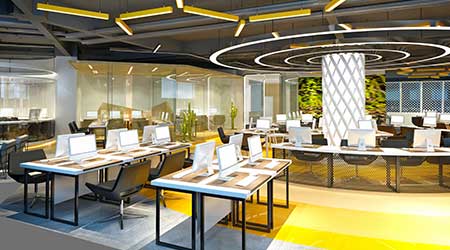5 Benefits of Unassigned Seating
Though there may be some skepticism at first, workers returning to the office do stand to benefit from not having an assigned desk. Here's how FMs can ease the transition.
By Dave Lubach, Managing Editor
Workers returning to the office in the wake of the COVID-19 pandemic, and how to comfortably welcome them back, is a pressing question facility managers are wrestling with these days.
Because people have worked remotely for as many as 15 months, many have reached a comfort level using their kitchen tables, desks, or couches as their workspace.
It may seem like the work-from-home push has been a recent trend attributed to the pandemic, but the desire for more flexible work options has been a long time coming.
“All COVID did was accelerate this transition that was already happening,” says John Campbell, the president of FCA, an architectural firm that specializes in workplace planning and designs. “Some companies in the ’80s and ’90s had a remote working policy. In 2011 a GSK (GlaxoSmithKline, a pharmaceutical company) CEO said they had to get out of their Ivory Tower and sit just like everyone else on the first floor so people can see leadership.”
One way that companies might adapt in a post-COVID world is through the emergence of unassigned seating in the workplace. Campbell has built a company and a career on helping companies build the concept for their own workspaces. Recently, he shared five benefits of unassigned seating.
1. Agility: They say variety is the spice of life, and many workers these days, especially coming off a long time working at home, seek flexibility.
“I think (unassigned seating) creates a truly agile work environment where you create a variety of different work settings,” Campbell says. “Typically when everyone has an assigned desk, you’re giving out 100 percent desks. What we’re seeing now is companies getting out eight desks for every 10 people assigned to the building. And even that is generous.
“It will be interesting to see going into a hybrid situation, whether you even need that? Why are they coming in? They’re coming in because they want to socialize, and they want to learn, but a lot of people are finding, particularly when kids go back to school, it might be easier to get focus work done at home, so why do we create an environment with a whole lot of desks?”
2. Remodeling/construction: If a change is required in the office, it’s easier to move people around.
“If you have an unassigned seating policy, you can adapt to changing business needs instantly. You may have to do construction work and demolish some offices, put other offices somewhere else, and that would be a business interruption. So if a particular department needs to grow, you can define the blocking and stacking (of teams) and you have zones. You can zone certain departments for a couple of months.”
3. Flexibility: For workers who do come to the office, especially younger employees, they don’t want to remain confined to one area, depending on their task, whether they are working alone or collaborating with other team members.
“We have to get people starting to think of the office like their home,” Campbell says. “At home, you don’t think of it as one room, you think of it as a variety of rooms in different settings depending on what you’re doing in the house.”
4. Hygiene: Even as the pandemic winds down, practices such as social distancing and deep cleaning are expected to continue to some extent in some workplaces. An unassigned seating policy can help navigate managers through those aspects of the office cleaning process.
“Disinfectant wipes are readily available and if you’ve got unassigned seating, and all of a sudden you have to change the physical/social distancing requirements, you can just take out some desks and say you can’t use this desk,” Campbell says. “In a normal manner, someone would have to move. In this instance, we can just choose a desk, because it’s free seating.”
5. Egalitarian approach: With everyone sitting together, regardless of position, all employees are treated equally and on the same plane.
“If everyone gets the same desk, status is more focused on your talent and results than your position in the company,” Campbell says. “We had a new employee who started just before COVID, and she was straight out of school and she didn’t know who I was. She asked who I was and when I said I was the president, she was mortified that she was going to be sitting 4 feet away from me. But in two weeks she was totally comfortable with it.”
Related Topics:












